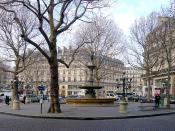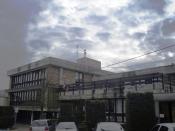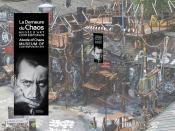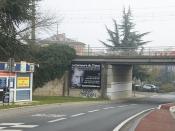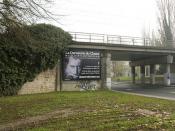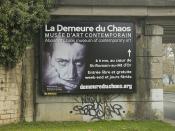History of Andre MalrauxâÃÂÃÂs ManâÃÂÃÂs Fate The French writer Andre Malraux succumbed to his fascination with Oriental culture when he wrote the book, ManâÃÂÃÂs Fate, which won him the Prix Goncourt in 1933. His frequent trips to Asia familiarized him with Oriental culture and history. The book is his personal indictment of the beaurocratic society, which had humiliated him during his stint in Indochina as founder of the newspaper L'Indochine. His entire body of work follows the groundswell of contemporary ideologies, from the Chinese nationalist and Communist revolution of the twenties to the Spanish Civil War of 1936, not forgetting his obstinate and stubborn battle against Nazism (Raynouard). A particular episode of the Chinese revolution provided inspiration for the book; there was an attempt on Monin's life by an Annamese, which was most probably paid by the Chinese criminal investigation department itself. This attempted murder had such an impact on Malraux that he began ManâÃÂÃÂs Fate with the scene of the killer pulling aside Monin's mosquito net by night, brandishing the razor with which he was to attack him.
ManâÃÂÃÂs Fate is considered one of his most masterful pieces of work based on real life events that happened during his lifetime. MalrauxâÃÂÃÂs theme in this novel is the solitude that distinguishes the human condition, and he draws his characters from a variety of national backgrounds and examines the political and personal differences, which mark them as, isolated, alienated beings. For them, revolution is a means by which they can transcend their lives and their feelings of despair. Malraux focuses on the Shanghai uprising of 1927, which was organized by the communists and repressed by the nationalist General Tchang-Kai-Shek. The three main characters in the story are Kyo, son of a Japanese mother and a French intellectual; Katov, Russian militant; and Chen, the terrorist, who is the only Chinese character in the team (Lacouture 145).
Although the particular historical events around which his novels revolve may change, several recurrent themes dominate MalrauxâÃÂÃÂs literary perspective. For instance, exoticism and violence, blindness and suffering, and the ubiquitous presence of death appear throughout his writings. Malraux portrays the human condition as tragic, but it is precisely in confronting this situation, that man experiences hope. His novel, therefore oscillate between the pessimism of individual existence and the optimism of collective action.
He called his book a report, but it is in fact largely a work of fiction. Newspaper cuttings, and pieces of information taken from his friend Georges Manue, a reporter who had covered the communist militant uprising in China, form the basis of a storyline (Lacouture 146). Malraux's The following are objectives are clearly defined in ManâÃÂÃÂs Fate: to show the tribulations of a developing world, to shape people who express the aspirations of a tormented time, and to depict man's combat with destiny. Indeed, in the title itself, ManâÃÂÃÂs Fate makes reference to Pascal and to metaphysics. Malraux rejects pleasant picturesque images, because he aims to put the emphasis on the relationship between the individual and collective action, and he portrays in his novel the conflict between man and fatality (Thompson and Viggiani 24-26). He wishes to go straight to the point, and thus only describes outward appearances in a cursory way. The setting for the action or of the thought it provokes is not described in itself, but in relation to the consciousness of the characters.
Andre Malraux came from a broken home and had great empathy for the working class. After attending the Lycée Condorcet, Malraux studied oriental languages at the ÃÂcole des Langues Orientales, but left his studies without graduating. After a brief stint of working for bookdealers and publishers, he went to Cambodia at the age of 21 with his wife, the writer Clara Goldsmidt. In 1923, Malraux made a trip to Cambodia where he and his wife, âÃÂÃÂ...were arrested by the Surete and charged with archaeological theft [...] a moral failure that Malraux now at last recognized in himselfâÃÂà(Lebovics). Assassination and violence were a common occurrence in China during the revolutionary years. The peasants were abused by the wealthy citizens and landowners, ...it was from among their relatives and protégés that those who oppressed and lived off the peasantry were recruited: the bailiffs and stewards who not only collected the rents and debts due to their masters, but also took a substantial cut for their own benefit; the tax-gatherers in whose registers the landlordsâÃÂàholdings were on an authorized âÃÂÃÂspecial listâÃÂÃÂ, allowing them to pay taxes in inverse proportion to their wealth, or not at all (Chesneaux 81-82). "Malraux's career begins in mystery with the expedition to Indo-China, the obscure affair of the missing statues, a short term of imprisonment, and a plunge into Eastern politics. The details of these matters are still unknown to us, but it is their resonance that counts. With all their shadow and uncertainty they nevertheless suggest a purity of adventure. Malraux entered the European consciousness not as a writer but as an event, as a symbolic figure somehow combining the magical qualities of youth and heroism with a sense of unlimited promise." (William Righter in The Rhetorical Hero, 1964).
Andre Malraux has had many roles in the course of almost half a century of activity, and he relives them in a variety of patterns in his well-documented volume of recollections. As an Orientalist, revolutionary, novelist, anti-Communist, historian, and Minister of Culture since 1958, he has traveled widely and conversed with the great in many countries. He is one of a handful of men in his generation to have combined so fruitfully the life of the intellect and the life of action, and he understands as few men do this world of societies and individuals in conflict.
ManâÃÂÃÂs Fate is one of the most powerful and impassioned documents for understanding the dreams and temptations of the modern intellectual. Of all the works that came out of the Spanish Civil War, ManâÃÂÃÂs Fate gives the best idea of what traumatic experience meant in its early heroic phase. Whatever criticism may be leveled at them, his major novels which once seemed advanced in their rapid, elliptical, image-flashing, cinematographic technique have entered history.
For Malraux, being a great writer still meant being a prophet and unacknowledged legislator of mankind. It meant shaping oneâÃÂÃÂs life and work into a significant legend. But the new French writers are hardly interested in such grandiose ambitions and pass him by, for if he put the âÃÂÃÂabsurdâÃÂàon the literary map or obliquely questioned the value of literature for its own sake, he did so in a totally different way, based on different assumptions from theirs. He studies art and civilization, the work of a man largely self-taught, received short shrift from experts, and should doubtless be seen as part of the âÃÂÃÂuninterrupted meditationâÃÂàon value, on life and death, that has taken various forms, including novels, essays, and anti-memoirs (Contemporary Literary Criticism).
In 1933, Andre Malraux was awarded the Prix Goncourt for ManâÃÂÃÂs Fate and established his international reputation (André (Georges) Malraux). Malraux had absorbed Oriental culture due to his many trips to the Far East, and he does indeed use this work to make an indictment of the society, which had humiliated him in Indochina. Although he was not a militant supporter of the Chinese revolution, he nonetheless tried to steer Annamese nationalism in the direction of social emancipation, and this intention is the origin of ManâÃÂÃÂs Fate.
Malraux was thought of as an amoral adventurer in the colonial society of Pnom-Penh and Saigon, because of his archeological expedition in Cambodia. However, he was warmly received in Vietnamese militant circles. From his very first stay in Indochina, he came into contact with the lawyer Paul Monin, one of the key figures in the Annamese campaign. It was with him that Malraux launched, during his second stay in Indochina, the newspaper L'Indochine, and eventually L'Indochine enchainee. These newspapers denounced the repressive regime and the exploitation of rural people, as well as colonial administration. At this time there was an attempt on Monin's life by an Annamese who was most probably paid by the criminal investigation department itself. This attempted murder had such an impact on Malraux that he began ManâÃÂÃÂs Fate with the scene of the killer pulling aside Monin's mosquito net by night, brandishing the razor with which he was to attack him.
Andre Malraux developed his sense of social justice during his visits to Indochina. During one of these trips, he traveled to Indochina looking for Khmer statuary; later witnessed the struggle in China in 1927 between Communists and Nationalists, helped to organize the Republican Air Force in the Spanish civil war, and was a founder of the World League against Anti-Semitism (Year by Year). They also showed him another world, a different civilization, which could not fail to attract a young man who was fascinated by Khmer art. ManâÃÂÃÂs Fate is set at the time of Chiang Kai-Shek's struggle against the communists, its somewhat pessimistic view of life is countered by the more optimistic reassertion of human dignity and solidarity; clearly indicates the author's convictions. It also presents Oriental culture, which he must have got to know better thanks to the world trip he made in 1931 as a representative of the Gallimard publishing house. It was during this trip that he discovered China, especially Shanghai, and Japan, where the story is set.
The presentation of the environment is reduced to its simplest description, the protagonist's field of vision. Thus we as readers discover with Tchen, who is about to murder his victim, the city lights in the shadows, without getting a clear description of the city. Like Tchen's, our eyes focus on the mosquito net covering the sleeping man whose life is to be sacrificed to the revolution. The Asian city is not really described afterwards. In a vague description way, Malraux indicates the uprising is imminent. Thus the sounds he describes, instead of indicating the intense activity of a port, emphasize dramatic intensity; the whistle of the patrol boats which remind us of warships, and the pathetic nature of the sirens which is heard as a scream. Malraux's style is allusive. However, beyond what he sees, the visionary novelist imagines the lives of people who are suffering scandalous exploitation.
In the image of the Chinese working class, Malraux reaches an epic dimension. Depicting social injustice, he uses literary devices, which are similar to those of Zola, the author of Germinal (Emil Zola). In order to make an impact on the reader, he first uses a figure, then an oratory balance, before replacing the figure with a generic term, which implies amplification and magnification. Finally, he ends the sentence with an accumulation, designed to lay the emphasis on the diseases affecting the Chinese. However, unlike Zola, Malraux does not dwell on this indictment. The last sentence of this passage cleverly brings us back to the vision of nature shown at the beginning of the paragraph. The city seems shaken by a violent storm, and the reader cannot help seeing in the sudden outbreak of this cataclysm the uprising of the Shanghai people who, like nature, are capable of fury. Taking care to avoid writing a long-winded novel, Malraux eliminates superfluous description. The atmosphere of Shanghai is essentially conveyed through the consciousness of Kyo, the main organizer of the uprising.
As for the characters of his novels, they rarely impress by their individuality, but by their condensed reflections and astonishing actions. Considering his lifelong interest in the visual arts, it is surprising how little visual impact they made as individuals. Each one forms part of a total debate, and collectively they appear as the procession and the possibilities of his actions and dreams, his potentialities, some of which he transformed into actuality, the adventurer, the historian of art, and the leader of men. Through his very desire to reduce the place of the individual, he shapes his characters into living aspects of a metaphysical discussion about the past, present, and future destiny of men.
The complexity of the novel (especially its plot), its ideology, its somber atmosphere, its portrayals of violence and death, make ManâÃÂÃÂs Fate difficult or unpalatable to some. Yet in its investigation of suffering and metaphysical anguish, through powerful scenes and searching discussions of destiny, it has few rivals. According to Andre Malraux, himself, âÃÂÃÂMan is not what he thinks he is, he is what he hides.âÃÂà(Creative Quotations).
